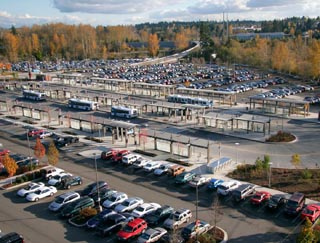|
Subscribe / Renew |
|
|
Contact Us |
|
| ► Subscribe to our Free Weekly Newsletter | |
| home | Welcome, sign in or click here to subscribe. | login |
Architecture & Engineering
| |
 |
January 22, 2013
ACEC National finalist: Gold award
Studies, research and consulting
North Corridor Transit Partners LLC (a joint venture of Parametrix and Parsons Brinckerhoff)
Project: North Corridor Transit Project alternatives analysis
Client: Sound Transit
Developing a transit project is fundamentally more sustainable than developing additional highways and roads. Transit projects generally make communities more livable by providing affordable mobility, helping with congestion management and lowering energy use and greenhouse gas emissions.
This was the logic that persuaded voters of the Central Puget Sound region in 2008 to approve the Sound Transit 2 plan that would add regional bus and commuter rail service and build 36 miles of light rail. As part of this expanded system, the North Corridor Transit Project, now called the Lynnwood Link Extension, will extend regional transit service north from Northgate in Seattle approximately 8.5 miles to Lynnwood.
Though voters already approved light rail, Sound Transit will still need federal funding to complete the project. To comply with the requirements of the Federal Transit Administration’s New Starts funding, an alternatives analysis had to be completed that evaluated multiple mode, route and station options.
The project team, led by the North Corridor Transit Partners, a joint venture of Parametrix and Parsons Brinckerhoff, developed a rigorous iterative process that was not only critical to meeting the FTA’s requirements, but also to maintaining the community’s trust in the project. Through this process, Sound Transit was able to engage the public and local decision-makers, confirm that light rail is the best mode of transit and that Interstate 5 is the preferred corridor, resulting in higher ridership, fewer impacts and less cost to develop than other alternatives.
The project will also require an environmental impact statement since it has the potential for causing environmental effects. But the EIS development process is expected to take 18 months instead of the typical three to five years, thanks to early scoping and the detailed and thorough alternatives analysis.
This study process is proving to be a model for other Sound Transit future extensions, including an extension south of Seattle-Tacoma International Airport. It also is helping the Washington State Department of Transportation identify possible ways to integrate light rail with future transportation improvements to I-5 in the project area.
From the outset, this process was inherently complex, involving multiple entities with statutory, regulatory, permitting or funding roles. Sound Transit CEO Joni Earl said, “Sound Transit is grateful to Parametrix and Parsons Brinckerhoff for their commitment to this project and ability to provide quality professional services within a highly political atmosphere.”
Other Stories:
- ACEC National finalist: Platinum award
Structural systems - ACEC National finalist: Gold award
Special projects - ACEC National finalist: Gold award
Energy - ACEC Best in State: Gold award
Complexity - ACEC Best in State: Gold award
Social/economic sustainability - ACEC Best in State: Gold award
Originality/innovation - ACEC Best in State: Gold award
Future value to engineering profession - ACEC Best in State: Gold award
Client expectations



